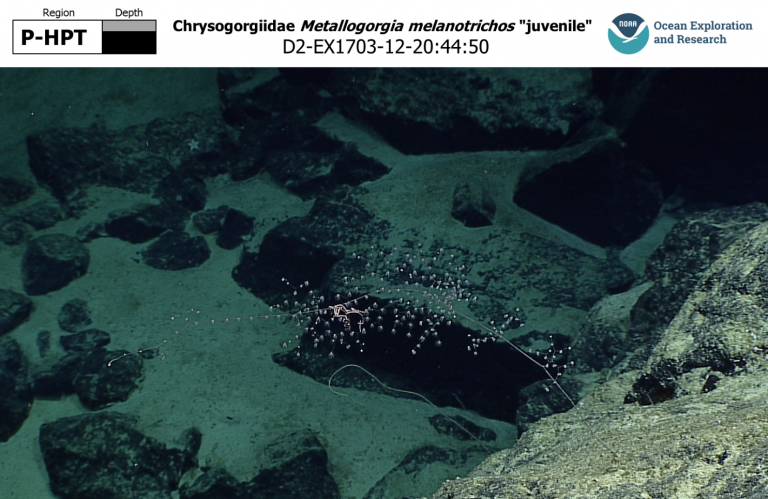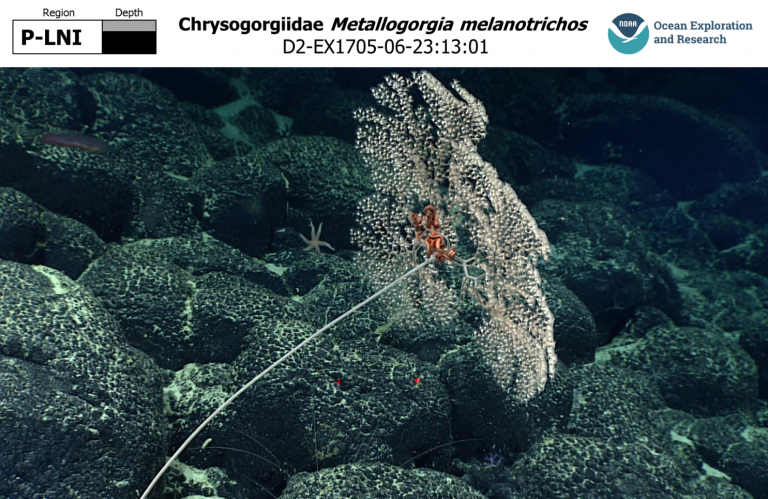How does a month-long voyage to the middle of the North Pacific Ocean sound? Spending thirty days on a ship with shared living spaces and nothing to see but ocean all around may not be your idea of a pleasure cruise, but each of the twelve members of the R/V Falkor science crew said, “Sign me up!”
I jumped at the opportunity to travel out to what looks like the middle of nowhere without even second thought. What would compel us to leave our families, the comforts of home, and dry land? The thrill of exploration and discovery, of course! I get to go to the farthest reach of our planet where very few explorers have looked at what lives below. My job on the ship is to annotate the Remotely Operated Vehicle (ROV) video imagery and try to write down every type of coral, sponge, fish, and other living creature that we encounter.
What am I looking at?
“Exactly what species of coral am I looking at?” is a question I often ask myself, but seldom can answer. Usually, we know what family or genus we are looking at, but species are not so easy to distinguish from one another. Some animals are difficult to identify simply because they have never been seen before! Another less obvious obstacle to identifying species from video is the fact that defining characteristics used by taxonomists to describe these species are often not easily seen with the naked eye.
Many of the original descriptions of deep-sea animals around the Hawaiian seamounts came from trawl surveys at the turn of the 20th century. Animals were brought up to the surface in nets, dissected, and inspected under a microscope. Often these descriptions were of small coral fragments, so we would not have a clear idea of what the whole animal would look like in their natural habitat. The way we observe the world has changed with technology over the last hundred years and now we have remotely operated vehicles with the capability of live-streaming high definition video to the world.
This is an era of rediscovery, where animals that we thought we knew and understood come to life in new ways before our eyes. We cannot just stick a coral under a microscope to count the scales, rods, and sclerites inside their skin while the ROV is down there. We have to find different characteristics that define and distinguish corals underwater and connect the dots to how they look on land. To make matters even more complicated, a lot of corals that are completely different species genetically can look very similar in morphology. Take the genus of bamboo coral called Lepidisis for example:

These gargantuan coral whips used to be called the same thing, but now genetic analyses tell us that they belong to completely different groups within the bamboo coral family. That is not the only way these corals have me bamboozled. Some species have different morphologies at different live stages, like the lacey golden coral, Metallogorgia melnotrichos:

 The top image is a juvenile M. melanotrichos, and the bottom image is the same species as an adult. Can you spot the difference?
The top image is a juvenile M. melanotrichos, and the bottom image is the same species as an adult. Can you spot the difference?
The only way to figure these corals out is to keep observing and documenting them in as many ways as possible – video, microscopy, genetics, and use the methods together to understand the whole picture. I feel like researching the deep-sea is like eating the “subtraction stew” in Norton Juster’s Phantom Tollbooth: The more you learn, the less you feel you know, and you are only left hungrier for more knowledge.

